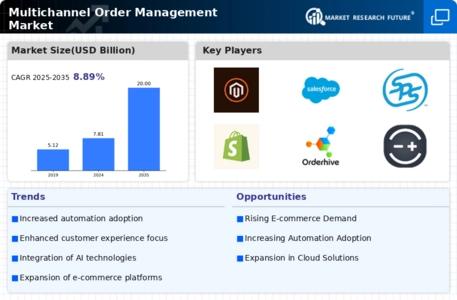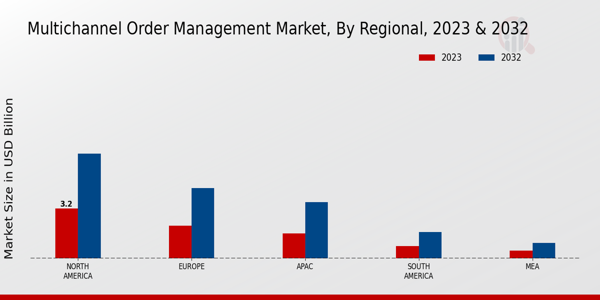Market Growth Projections
The Global Multichannel Order Management Market Industry is poised for substantial growth, with projections indicating a market size of 7.81 USD Billion in 2024 and an expected increase to 20.0 USD Billion by 2035. This growth trajectory, characterized by a compound annual growth rate of 8.93% from 2025 to 2035, reflects the increasing importance of effective order management in a multichannel retail environment. The demand for streamlined operations, enhanced customer experiences, and efficient supply chain management drives this expansion. As businesses continue to adapt to changing consumer behaviors and technological advancements, the multichannel order management market is likely to evolve, presenting new opportunities for innovation and investment.
Rising E-commerce Adoption
The Global Multichannel Order Management Market Industry experiences a surge in demand due to the rapid growth of e-commerce. As consumers increasingly prefer online shopping, businesses are compelled to adopt multichannel strategies to meet customer expectations. In 2024, the market is projected to reach 7.81 USD Billion, reflecting the necessity for efficient order management systems that can handle diverse sales channels. Companies that leverage these systems can streamline operations, reduce fulfillment times, and enhance customer satisfaction. This trend indicates a significant shift in retail dynamics, where traditional businesses must adapt to the digital landscape to remain competitive.
Expansion of Retail Channels
The expansion of retail channels, including social media and mobile platforms, significantly influences the Global Multichannel Order Management Market Industry. As retailers diversify their sales channels, they require robust order management systems to ensure consistent customer experiences across platforms. This diversification not only increases sales opportunities but also complicates inventory management and fulfillment processes. The anticipated growth of the market, reaching 20.0 USD Billion by 2035, highlights the necessity for businesses to adopt integrated solutions that can manage orders from various sources efficiently. Retailers that embrace this trend are better positioned to capture market share and enhance customer loyalty.
Global Supply Chain Optimization
The need for global supply chain optimization is a critical driver for the Global Multichannel Order Management Market Industry. As businesses expand their operations internationally, they face complex logistics challenges that require efficient order management systems. These systems facilitate better coordination among suppliers, warehouses, and distribution centers, ultimately leading to reduced operational costs and improved service levels. The increasing focus on sustainability and cost-effectiveness further emphasizes the importance of optimizing supply chains. Companies that effectively manage their global supply chains are likely to enhance their competitiveness and profitability in the evolving marketplace.
Increasing Consumer Expectations
Consumer expectations are evolving, driving the Global Multichannel Order Management Market Industry towards greater efficiency and responsiveness. Customers now demand faster delivery times, seamless shopping experiences, and personalized services. This shift compels retailers to adopt sophisticated order management solutions that can integrate various sales channels and provide real-time inventory visibility. The market's projected compound annual growth rate of 8.93% from 2025 to 2035 suggests that businesses must prioritize customer-centric strategies to thrive. Companies that fail to meet these expectations risk losing market share to competitors who can deliver superior service and engagement.
Integration of Advanced Technologies
The integration of advanced technologies such as artificial intelligence and machine learning is transforming the Global Multichannel Order Management Market Industry. These technologies enable businesses to analyze consumer behavior, optimize inventory management, and predict demand more accurately. As a result, companies can enhance their operational efficiency and reduce costs. The anticipated growth from 2024 to 2035, with a projected market size of 20.0 USD Billion, underscores the importance of technological innovation in order management. Organizations that invest in these technologies are likely to gain a competitive edge, as they can respond more swiftly to market changes and customer needs.














